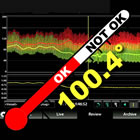 This week started off with me watching a demonstration of fractional flow reserve (FFR) during multivessel PCI. This very instructive case was transmitted live from Hammersmith Hospital in London and featured Dr. Justin E. Davies showing how to perform FFR and, more importantly, how the use of FFR changed the treatment plan for this patient.
This week started off with me watching a demonstration of fractional flow reserve (FFR) during multivessel PCI. This very instructive case was transmitted live from Hammersmith Hospital in London and featured Dr. Justin E. Davies showing how to perform FFR and, more importantly, how the use of FFR changed the treatment plan for this patient.
The angiogram had shown three intermediate blockages (LAD, OM, RCA) and, as such, this patient might have been a candidate for CABG instead of PCI. However, when FFR was used to measure whether or not these blockages were ischemic, two were found to be hemodynamically insignificant: it would be safe to defer stenting and treat them medically. The third lesion in the LAD clearly was the cause of the symptoms and stenting would have benefit for the patient.
Through the use of this not-new technology of fractional flow reserve, a potential triple bypass graft operation was converted to a simple single vessel angioplasty. Moreover, FFR identified the significant blockage as different from the one targeted by QCA angiography. Without the use of FFR, this patient might have gone to surgery, or might have had one or two extra stents placed and, if only one, it might well have been placed in the wrong artery.
Fractional flow reserve has been validated by several pivotal studies, such as DEFER, FAME, and FAME 2. The FAMEs used a cut point of 0.80. Above the cut point, the blockage was considered hemodynamically insignificant and was left untreated. At or below the cut point, the lesion was stented. Patient outcomes improved by a third (after one and two years) in FAME. And virtually no patient whose PCI was deferred wound up back in the hospital for a stent. Clearly using FFR to deliver the right therapy to the right patient was superior. The U.S. and European Guidelines now incorporate and give a Class 1A or 2A for the use of FFR to determine ischemia.
So, great. There’s a tool to help make decisions. There’s a number that can guide therapy. Keep the word “guide” in mind, while I switch gears….
It seems that while I was watching the “Live from Hammersmith” FFR case on Monday, and being shown that the threshold of 0.80 was a way of determining whether or not to stent, a nurse was calling the Centers for Disease Control (CDC) to ask if it would be okay for her to fly over the weekend, even though she had been closely involved in treating the Ebola patient in Dallas, and had a “slightly elevated temperature.” Her temperature was 99.5° and, according to reports, the CDC told her that she was below the “evidence of Ebola” threshold of 100.4°, and she “was not told that she could not fly.” Stent, no stent; fly, no fly. It’s all in the numbers. Actually…not.
Over two years ago I wrote an article for Angioplasty.Org about stent decision-making using functional measurement tools, like FFR, or the recently introduced technology iFR (Instant Wave-Free Ratio) developed, in part, by Dr. Justin Davies – yes the same Dr. Davies from the live broadcast. My article asked, “What’s in a Number?,” and an important comment came from, yes, Dr. Davies again:
One clear message is the value of a cardiologist’s clinical judgement. Objections from veteran cardiologists to using FFR as a guide to stent-or-not-to-stent decisions has been that they don’t want to be held to a number, whether it’s 0.79 or 0.81, when making such an important and impactful decision for the patient on the cath lab table. Dr. Davies agrees and told Angioplasty.Org:
Justin E. Davies, MD, PhD
“Essentially the metric which we’re judging iFR against is a value which is moving around. If you have an FFR of 0.81, it could anywhere from a probability perspective as high as 0.83, 0.84 or go down to 0.76 — so actually we don’t know in fact if someone should be treated or not treated. But what we do know is it’s very close to the significant value where it’s going to be a problem. So it would be very reasonable to use clinical judgement. Have a lot of chest pain and had a value of 0.82? It could be as low as 0.76. So you should go ahead and treat and vice-versa. That’s one thing we learned from this. Physicians should be given a bit more scope in these areas.
“I would not want to overstate any claim about iFR, FFR or any of these indexes because at the end of the day, if someone is in front of you, and they’ve got really bad chest pain, and the number says it’s .01 off the cut-point for treatment, that’s mad, that’s a crazy world to be in.”
So, back to Ebola. Yes, it would be crazy to make a decision based on a threshold of 100.4° alone, when the context, the facts staring you in the face are that this person may be infected with Ebola (and she was!). I’m sure the 100.4° figure was never meant to be interpreted as a digital gatekeeper. It was incorporated into the guidelines but, you know, “guidelines,” are supposed to be “guides” (hence the name) for physicians in making decisions. Guides. Not rules or commands or yes/no up/down decisions.
And now back to interventional cardiology (last time I do the switch, I promise!) Numbers, such as FFR, etc., are incorporated into the multi-society guidelines for performing PCI and, following a decision-tree of questions, the correctness of placing a stent is labeled: Appropriate, Uncertain, Inappropriate. There’s actually “an app for that.” But these labels are meant as a guide to decision-making. Any interventional cardiologist will tell you, there are times when an “Inappropriate” procedure is totally “Appropriate.”
The problem comes in using a number alone in automatically calculating and rendering a black and white digital yes or no decision. As seen this week, that can be dangerous.
Dangerous or not, it’s beginning to happen in the administrative bureaucracy of the healthcare world. A couple weeks ago, I wrote how New York State Medicaid had decided to make reimbursement decisions based entirely and automatically on the three levels of appropriateness described in the guidelines. And, of course, reimbursement decisions become decisions for whether or not a patient will receive a certain therapy. So those patients for whom the “Inappropriate” label is actually appropriate in their particular clinical scenarios would be denied the best treatment. Again, guidelines are “guides,” not rules or pieces of legislation. As I reported, this particular development was somewhat modified by the outrage and outreach of the invasive cardiology community, but there will be more battles like this one to come, for sure.
The lesson from both of this week’s events is that there’s a recipe for making a proper medical decision: take a threshold or cut point, place it in a guideline, stir well and add a large dose of clinical judgement.
* * * * *
By the way, you can watch the archived video of the “Live from Hammersmith” FFR case online. Just turn down the volume for the opening titles 😉
* * * * *
And, if you feel that I’ve mixed too many metaphors in the above post, please vote “Appropriate,” “Uncertain,” or “Inappropriate” in the comments below. I look forward to your tweets and emails.





Excellent comparative overview between seemingly unrelated decision-making scenarios, Burt. I had to laugh at your final cautionary warning to turn down the volume on that “Live From Hammersmith” FFR video opener – I fully expected stage curtains to part and a feature-length studio production to begin…